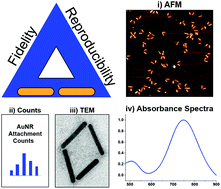Analyzing Fidelity and Reproducibility of DNA Templated Plasmonic Nanostructures
Synthetic DNA templated nanostructures offer an excellent platform for the precise spatial and orientational positioning of organic and inorganic nanomaterials. Previous reports have shown its applicability in the organization of plasmonic nanoparticles in a number of geometries for the purpose of realizing tunable nanoscale optical devices. However, translation of nanoparticle–DNA constructs to application requires additional efforts to increase scalability, reproducibility, and formation yields. Understanding all these factors is, in turn, predicated on in-depth analysis of each structure and comparing how formation changes with complexity. Towards the latter goal, we assemble seven unique plasmonic nanostructure symmetries of increasing complexity based on assembly of gold nanorods and nanoparticles on two different DNA origami templates, a DNA triangle and rhombus, and characterize them using gel electrophoresis, atomic force- and transmission electron microscopy, as well as optical spectroscopy. In particular, we focus on how much control can be elicited over yield, reproducibility, shape, size, inter-particle angles, gaps, and plasmon shifts as compared to expectations from computer simulations as structural complexity increases. We discuss how these results can contribute to establishing process principles for creating DNA templated plasmonic nanostructures.


Leave a Reply